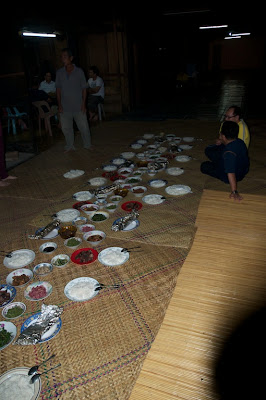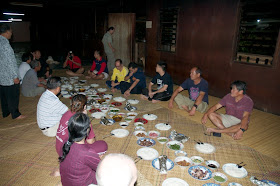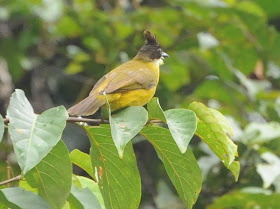After
many shaky hours on the road (at an average speed of just over 8
km/h!), we arrived at Pa Mada on the evening of January 15, 2012. Our intention was to stay there
overnight, but vehicle problems and road conditions kept us there for
three days. I wasn't sorry, because it gave me a chance to enjoy both a nice part of the country and the friendly hospitality of the longhouse.
The community was, in fact, preparing to receive a VIP guest (Sarawak Deputy Chief Minister Alfred Jabu). The longhouse was ready for a feast, set out on woven mats running down the longhouse floor.
After recovering from our drive, we joined residents and the visiting party for a dinner of traditional Kelabit dishes. The gentleman in the green shirt taking some food from a bowl is Eileen's relative Gerawat Gala, a Kuching-based lawyer who at the time was President of the Kelabit Association (RURUM Kelabit Sarawak).
Over the next few mornings I found that there was some nice birding to be had in the vicinity - particularly along the road towards the nearby kampung of Pa Dali.
All I had to do was stroll out past the odd Water Buffalo (and its attendant Eastern Cattle Egrets [Bubulcus coromandus]), and explore along the forest edge.
Here I found a bird recently elevated to the status of a mid-montane Borneo endemic: the Bornean Bulbul (Pycnonotus montis), formerly included with the Black-crested Bulbul (P. melanicterus) of Peninsular Malaysia. Notice the pale throat; in the Black-crested the throat is either black or red, depending on the subspecies. This is not the best photo, I know, but the species was new to me; it is rare on Mount Kinabalu in Sabah and I have never seen it at Borneo Highlands.
Here is more widespread and common highland species: the Ochraceous Bulbul Alophoixus ochraceus). I also found, but could not photograph, a distant party of Straw-headed Bulbuls (Pycnonotus zeylanicus) - to my surprise, as this heavily trapped species has become rare almost everywhere.
The community was, in fact, preparing to receive a VIP guest (Sarawak Deputy Chief Minister Alfred Jabu). The longhouse was ready for a feast, set out on woven mats running down the longhouse floor.
After recovering from our drive, we joined residents and the visiting party for a dinner of traditional Kelabit dishes. The gentleman in the green shirt taking some food from a bowl is Eileen's relative Gerawat Gala, a Kuching-based lawyer who at the time was President of the Kelabit Association (RURUM Kelabit Sarawak).
Over the next few mornings I found that there was some nice birding to be had in the vicinity - particularly along the road towards the nearby kampung of Pa Dali.
All I had to do was stroll out past the odd Water Buffalo (and its attendant Eastern Cattle Egrets [Bubulcus coromandus]), and explore along the forest edge.
Here I found a bird recently elevated to the status of a mid-montane Borneo endemic: the Bornean Bulbul (Pycnonotus montis), formerly included with the Black-crested Bulbul (P. melanicterus) of Peninsular Malaysia. Notice the pale throat; in the Black-crested the throat is either black or red, depending on the subspecies. This is not the best photo, I know, but the species was new to me; it is rare on Mount Kinabalu in Sabah and I have never seen it at Borneo Highlands.
Here is more widespread and common highland species: the Ochraceous Bulbul Alophoixus ochraceus). I also found, but could not photograph, a distant party of Straw-headed Bulbuls (Pycnonotus zeylanicus) - to my surprise, as this heavily trapped species has become rare almost everywhere.

The Gold-whiskered Barbet (Megalaima chrysopogon), a widespread Southeast Asian species, is the largest barbet in Borneo.
I
did not have an altimeter with me, but I would place Pa Mada at the
interface between the highlands and the low country. Thus, along with typical lowland species, I found Chestnut-hooded Laughingthrushes (Rhinocichla treacheri, a bird I normally associate with
higher elevations. Pa Mada was
also the only place on our trip I saw Pygmy White-Eyes (Oculocincta squamifrons), a common species at Borneo Highlands. Both are Borneo endemics.
On two
successive days, I came across a noisy party of about ten Dusky Broadbills (Corydon sumatranus), a species I had long wanted to see. Aside from their extraordinary bills, they are quite unlike other broadbills I have seen - the party reminded me more of a gang of jays or laughingthrushes than of the other broadbills I have come across.
The broadbills appeared to be a core
flock species, gathering around them birds such as Chestnut-breasted
Malkohas (Phaenicophaeus curvirostris) - and, with them, pygmy squirrels (I could not be sure of the species). I find it quite fascinating
that small squirrels join bird parties both in Borneo and Central
America - a quite independent development, as the two groups of
squirrels are not close relatives.
I was surprised by how few migrants I saw in the highlands - a number of migrant flycatchers, for example, winter in Borneo hill country and should not be that hard to find in January - but I did spot this immature Tiger Shrike (Lanius tigrinus) in a thicket along the road.
The peculiar, spiky growths on this plant, a woody vine growing over some low trees near the kampung, are not fruits. This is an ant plant, a member of the genus Myrmecodia, and the spiky object in the photograph is an aerial tuber adapted to provide a home for ants. As it grows it becomes riddled with tunnels leading to entrance holes on the outside. The ants that live there defend the plant against enemies, and their waste materials provide their host with extra nutrients.
The famous naturalist Alfred Russel Wallace wrote about this fascinating symbiotic relationship well over a century ago: "In the Malay islands are several curious shrubs belonging to the Cinchonaceæ [now Rubiaceae], which grow parasitically on other trees, and whose swollen stems are veritable ants' nests. When very young the stems are like small, irregular, prickly tubers, in the hollows of which ants establish themselves; and these in time grow into irregular masses the size of large gourds, completely honeycombed with the cells of ants."
I have complained before about the difficulty in identifying Bornean butterflies of the genus Ypthima. I don't know which one this is, either. Anyone?
On to dragonflies.
OK, how do I know (or think I know) that this dragonfly is Neurothemis ramburii and not one of its similar-looking relatives? Take a look at the base of the hindwing. Now count four rows down from its leading edge. Do you see that there are two long, narrow rectangles marked off by veins? Right in front of them is a long, narrow space (the median space) with no veins at all. In other Neurothemis that set of two rectangles (the cubital space) would be replaced by a whole bunch of little squares. The cubital space would be crossed by several veins, dividing it into boxes, rather than just one. Here there is only one cross vein, and that makes this a typical ramburii (well, at least according to A.G. Orr's A Guide to the Dragonflies of Borneo). Got that?
This dragonfly, perching on the trail, is a male Blue Percher (Diplacodes trivialis).
Photgraphing dragonflies in flight is a difficult task (well, it is for me). I was very happy, therefore, to find this male Orthetrum chrysis hovering obsessively in one spot where I could focus on it and snap away. I am rather pleased with myself over the result, which is why you are being treated to two nearly identical photographs.
After my morning walks I could other relax at the longhouse or join Isai for a tour of the kampung's orchards. Here I am doing the latter, with (as I suspect the photo betrays) a certain amount of trepidation as I cross a rather unsteady-looking footbridge.
It may not look like one (I thought it was a sort of breadfruit at first), but this is a species of mango endemic to Borneo, Mangifera pajang [thanks again to Sean L for correcting my original identification as M. foetida]. Its fruits are seldom eaten raw, but are commonly used in the highlands as an ingredient in stews. It has a number of local names, including bambangan (kedazan) and mawang (iban). Its Kelabit name is bua' laam.
This is a breadfruit relative: Terap (Artocarpus odoratissimus), a fruit I first tasted at Isai's farm in Kuching.
Isai goes to considerable lengths to harvest his fruits!

 The blossoms on this beautiful flowering vine were not fully open, and I have no idea what they are (or if the plant bearing them was growing naturally or had been planted in the orchard). Identifications would be welcome! [and were not long in coming thanks to Sean L: Toothbrush Orchid (Dendrobium secundum). Thanks!]
The blossoms on this beautiful flowering vine were not fully open, and I have no idea what they are (or if the plant bearing them was growing naturally or had been planted in the orchard). Identifications would be welcome! [and were not long in coming thanks to Sean L: Toothbrush Orchid (Dendrobium secundum). Thanks!]
Back at the longhouse I photographed this mounted pig jawbone, probably from a Bearded Pig (Sus barbatus) though it could be the remains of a domestic animal.
 This spectacular spider, like an oversize, ornate black widow, suspended its web at the edge of the longhouse balcony.
This spectacular spider, like an oversize, ornate black widow, suspended its web at the edge of the longhouse balcony.
 Rather to my surprise, I have not been able to identify it - not that I am a spider expert (I am certainly not) but because, despite repeated internet image searches, I have failed to find anything quite like it. I would really be curious to know what it is! [Update 10 Feb 2014: it's a hermit spider, Nephilengys malabarensis. Thanks to the excellent Spiders of Borneo, just published by Natural History Publications (Borneo), for the ID!]
Rather to my surprise, I have not been able to identify it - not that I am a spider expert (I am certainly not) but because, despite repeated internet image searches, I have failed to find anything quite like it. I would really be curious to know what it is! [Update 10 Feb 2014: it's a hermit spider, Nephilengys malabarensis. Thanks to the excellent Spiders of Borneo, just published by Natural History Publications (Borneo), for the ID!]
While I explored the natural history of the area, of course, life went on around me. These two women posed for me before heading out to harvest the rice crop...
..while Pun Nibu, the oldest resident of the longhouse, then in his 90s (he has since passed away), sat for his portrait with his beaded staff, and the heavy brass earrings and stretched earlobes that were once a mark of every Kelabit.
The peculiar, spiky growths on this plant, a woody vine growing over some low trees near the kampung, are not fruits. This is an ant plant, a member of the genus Myrmecodia, and the spiky object in the photograph is an aerial tuber adapted to provide a home for ants. As it grows it becomes riddled with tunnels leading to entrance holes on the outside. The ants that live there defend the plant against enemies, and their waste materials provide their host with extra nutrients.
The famous naturalist Alfred Russel Wallace wrote about this fascinating symbiotic relationship well over a century ago: "In the Malay islands are several curious shrubs belonging to the Cinchonaceæ [now Rubiaceae], which grow parasitically on other trees, and whose swollen stems are veritable ants' nests. When very young the stems are like small, irregular, prickly tubers, in the hollows of which ants establish themselves; and these in time grow into irregular masses the size of large gourds, completely honeycombed with the cells of ants."
I have complained before about the difficulty in identifying Bornean butterflies of the genus Ypthima. I don't know which one this is, either. Anyone?
On to dragonflies.
OK, how do I know (or think I know) that this dragonfly is Neurothemis ramburii and not one of its similar-looking relatives? Take a look at the base of the hindwing. Now count four rows down from its leading edge. Do you see that there are two long, narrow rectangles marked off by veins? Right in front of them is a long, narrow space (the median space) with no veins at all. In other Neurothemis that set of two rectangles (the cubital space) would be replaced by a whole bunch of little squares. The cubital space would be crossed by several veins, dividing it into boxes, rather than just one. Here there is only one cross vein, and that makes this a typical ramburii (well, at least according to A.G. Orr's A Guide to the Dragonflies of Borneo). Got that?
This dragonfly, perching on the trail, is a male Blue Percher (Diplacodes trivialis).
Photgraphing dragonflies in flight is a difficult task (well, it is for me). I was very happy, therefore, to find this male Orthetrum chrysis hovering obsessively in one spot where I could focus on it and snap away. I am rather pleased with myself over the result, which is why you are being treated to two nearly identical photographs.
It may not look like one (I thought it was a sort of breadfruit at first), but this is a species of mango endemic to Borneo, Mangifera pajang [thanks again to Sean L for correcting my original identification as M. foetida]. Its fruits are seldom eaten raw, but are commonly used in the highlands as an ingredient in stews. It has a number of local names, including bambangan (kedazan) and mawang (iban). Its Kelabit name is bua' laam.
This is a breadfruit relative: Terap (Artocarpus odoratissimus), a fruit I first tasted at Isai's farm in Kuching.
Isai goes to considerable lengths to harvest his fruits!


Back at the longhouse I photographed this mounted pig jawbone, probably from a Bearded Pig (Sus barbatus) though it could be the remains of a domestic animal.


While I explored the natural history of the area, of course, life went on around me. These two women posed for me before heading out to harvest the rice crop...
..while Pun Nibu, the oldest resident of the longhouse, then in his 90s (he has since passed away), sat for his portrait with his beaded staff, and the heavy brass earrings and stretched earlobes that were once a mark of every Kelabit.

























+m.JPG)











The shocking pink-purple flower buds are that of Dendrobium secundum, the toothbrush orchid. They come in various shades of purple to pink to an alba form and is native to this region. Common in Java, the seasonal climate forces them into spectacular bloom. Alas, my var. alba specimen has never flowered before, due to the constant watering and lack of dry season. Bambangan is Mangifera pajang, the appearance of the veins on the leaves and the colour of the fruit and the peel texture is an unmistakable character.
ReplyDeleteA question: is the fruit in the photo M. pajang, or are you saying that the fruit I am showing is M. foetida but the name bambangan applies to M. pajang rather than to the tree in the photo?
DeleteThe fruit in the photo is M. pajang, sorry for being cryptic.
DeleteThanks!
ReplyDelete